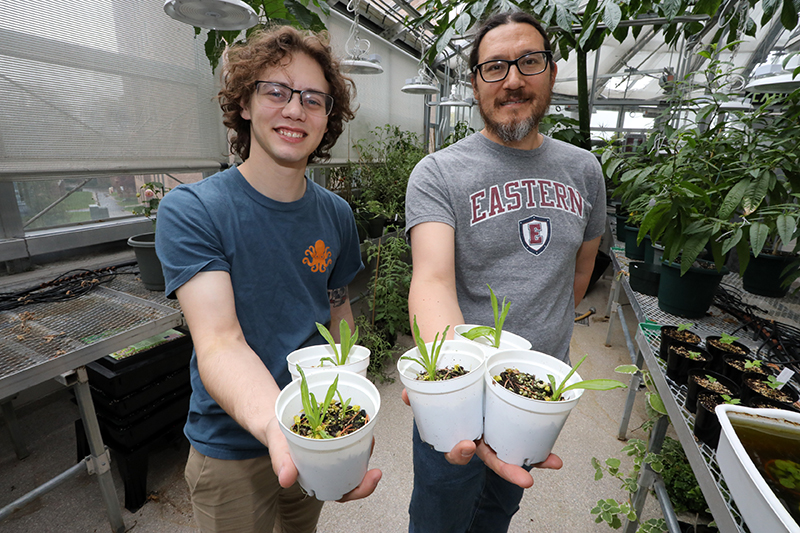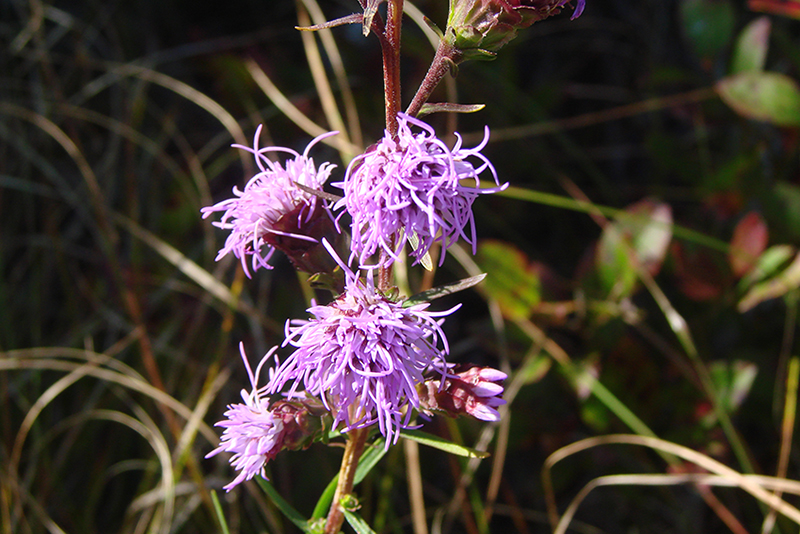- Apply
- Visit
- Request Info
- Give



Published on May 03, 2023

A new method that shortens the germination time of an endangered New England wildflower is described in a paper to be published in the Native Plants Journal by Eastern Connecticut State University student Dylan Tillman ’23 and biology Professor Bryan A. Connolly.
The rare northern blazing star wildflower, Liatris novae-angliae, native to Connecticut, Massachusetts and other New England and northeastern states, is a protected species that state agencies and environmental nonprofits have been trying to re-introduce and augment in the wild.
“Because it’s a native plant, endemic to New England, we want to try to preserve it,” said Tillman. The wildflower’s favored habitat is dry, open areas, mostly on Cape Cod; interior sandy areas; and traprock or basalt ridges. In Connecticut, it is usually found in the western part of the state.
Threats to the species include development, use of herbicides, mowing, browsing by deer and rabbits and overcollection, Tillman and Connolly wrote. State agencies and environment nonprofits have been working to re-introduce it, germinating seeds and replanting the wildflower where it might thrive.
Seeds of the northern blazing star are usually prepared for germination by cold stratification, which exposes them to the cold temperatures they would experience outside in the winter.
This standard way to germinate the seeds often takes 60 days, but Tillman and Connolly found that by using a common plant growth regulator, ethephon, they could germinate the northern blazing star seeds in as short a time as two weeks.

Speeding up gemination would help restore the northern blazing star by making more plants available faster. Waiting two months for cold stratification to germinate the seeds can delay planting for an entire growing season if some of the seedlings fail to survive, noted the Eastern biologists in their paper.
Ethephon has been used to speed up germination in a related plant, the purple coneflower, or Echinacea purpurea, and that is how the researchers got the idea to try it on the northern blazing star. It turned out to be “a madly wild success,” said Connolly.
They obtained the wildflower seeds from their co-authors Bryan Windmiller and Cara McElroy of Zoo New England, the parent organization of the Franklin Park Zoo in Boston. They diluted ethephon, placed the seeds in it, and left them under grow lights for two weeks before counting the seeds that had germinated. Other groups of seeds were treated with cold stratification in an unheated room that was about the same temperature as the outdoors. After 30, 60 or 90 days they were brought into Eastern’s biology greenhouse for germination.
Of the seeds treated with ethephon, germination after 14 days ranged from 64% to 71%, as good or better than the germination rate for the 60-day cold-stratified seeds but much faster. Control groups of seeds that were not treated with cold stratification nor ethephon had significantly lower germination rates of 9% or less.
“This investigation shows that ethephon treatment is as effective as the standard 60-day stratification at breaking seed dormancy in L. novae-anglaiae,” the researchers wrote. It is also faster and may allow greater flexibility for restoration projects, they noted.
Future experiments could be done, changing the ethephon concentration or varying light conditions or even mixing cold stratification and ethephon treatments, to possibly yield better results, they wrote.
Plants grown in their experiments will be used for restoring the northern blazing star in Massachusetts, where it was more abundant in the past. Zoo New England has been planting the wildflowers in appropriate habitats, Connolly said.
Tillman plans to attend graduate school at Western Connecticut State University to obtain a master’s degree in integrative biological diversity. He expects to continue the research he began at Eastern on arachnids. His foray into plant research with Connolly led to this paper, his first scientific publication, being accepted for an upcoming issue of Native Plants Journal.
Written by Lucinda Weiss